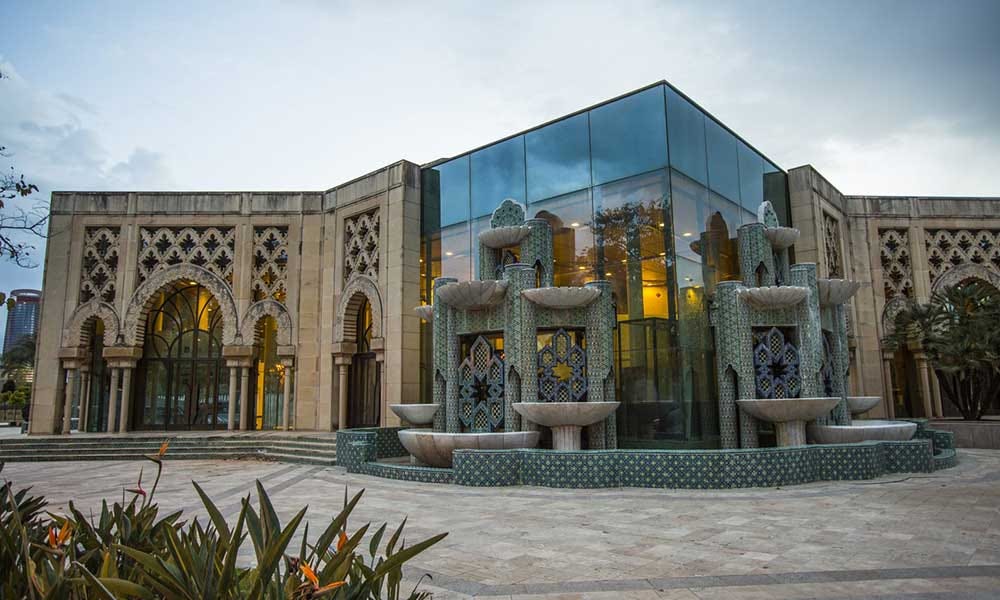Hola. This is Barbara with diverse cultural news from Spain this week. 1. The luxury real estate project Lagasca 99 in Madrid got media attention because some of its owners appear in the Pandora Papers. Well, who else could afford a flat in such a building? 2. Former Spanish prime minister Rodrigo Zapatero has published an essay on Jorge Luis Borges. 3. The last topic leads us to Seville and the foundation Tres Culturas del Mediterráneo.
Lagasca 99: Luxury is space
Lagasca 99 is a unique residential building designed by renowned architect Rafael de la Hoz. It is located in Madrid’s affluent barrio Salamanca. The luxury housing block fits very well into Madrid’s architecture with its glass façade and rounded corners. It offers spacious flats for 44 owners who are able to pay between 3 and 17 million Euros per unit.
El País has an excellent overview of the flats and the overall building, please, have a look. The two largest flats are located at the ends of the top floor. Both exceed 575 square metres. Meanwhile, the average size of dwellings in the Spanish capital is 82.9 square metres (although the median - the most common value - is 75 m2.) As states the architect himself: In our crowded cities, space is a scarce resource and, hence, becomes a luxury.
As in other European cities, these luxury apartments have also become good opportunities for rich foreigners to not only have another nice retreat, but also a good way to hide their money. As was revealed some weeks ago in the Pandora Papers, some owners of these new apartments did not acquire the apartments directly, but did so through opaque societies. This, for example, is the case with Jaime Gilinski, Colombia’s second richest man. In December 2018, he used Colden Investments SA, a company based in Panama, to sign a contract for the purchase of a flat in Lagasca 99. Gilinski's connection to Colden Investments does not appear in public records, but in the internal documents of Alemán Cordero y Galindo, one of the law firms whose files are part of the Pandora Papers. Of course, these investment vehicles are legal in their country of creation and one must assume “in dubio pro reo” keeping in mind that they may sometimes be used to launder money.
More than half of the buyers, as reveals El País come from the Americas: eleven from Mexico, six from the United States, five from Venezuela, two from Colombia and one from Peru. Three are businessmen with links to the Venezuelan government: a couple whose company has been subcontracted by the Brazilian construction company Odebrecht (one of the Latin America’s biggest corruption scandals ever), Tomás Niembro, right-hand man of Víctor Vargas, nicknamed “el banquero de Chávez”, and Luis Otero Cervela, a shareholder of Rowberrow Trading Corp, a company linked to the fraud of the Venezuelan oil company PDVSA's pension fund.
For Madrid, opening its real estate to exclusive international clients is still at an early stage - at least, that’s my impression from the El País article. The real estate agency Knight Frank in London confirms this impression in their report Prime Estate (p. 21):
The city offers competitive prices compared with other European capitals and a quality of development now beginning to rival that of London, Paris and New York.
Madrid is catching up quickly because ultra-rich buyers have become even richer in the last years and are eagerly looking for new investment opportunities without big political risk. In the long term, this high-end type of gentrification may lead to forced displacement of local residents, a fostering of discriminatory behaviour by people in power, and a focus on spaces that exclude low-income individuals. As a countermeasure an active housing policy would be necessary, which I do not expect from the current regional government.
A politician’s declaration of love to literature
While some persons of public interest use their former political careers to fill their accounts and special purpose vehicles, José Luis Rodríguez Zapatero has been pitching for another kind of career lately: He has written a book on Jorge Luis Borges: 'No voy a traicionar a Borges' (Editorial Huso), in which he reflects on the work of the Argentine author and professes his admiration for him. I was surprised when I read about him presenting his book at the end of September, because Zapatero is not a literary critic or a professor of literature. Between 2004 and 2011 he was the head of the socialist-led government of Spain. Therefore, the publication of this essay has been widely discussed in the Spanish press. I especially liked an interview with him in Zenda, in which he calmly reflects on his relationship with Borges and his way of writing, with literature in general, the doubts about Borges’s political points of view, and his recommendations for Spain’s ruling politicians.


Recommendable! I like Zapatero’s serenity and thoughtfulness in this interview. He has no need to brag about his literary knowledge. I haven’t had a chance to read the essay myself and am looking forward to doing so and having my doubts concerning Borges challenged (Unlike Zapatero, I don’t think Borges was a literary God, but is sometimes rather a little bit overrated). I’ll let you know if Zapatero convinced me.
Fundación Tres Culturas
Let us now travel South, to Seville, to visit another beautiful house: The headquarters of the foundation «Tres Culturas del Mediterráneo» are located on the Isla de la Cartuja in what was the Moroccan Pavilion during the Universal Exhibition in Seville in 1992.
You can do a virtual tour of the building - it’s amazing! I also watched a promotional talk by the new director of the foundation, Concha de Santa Ana Fernández. She’s a former member of Congress (PP). The talk was organised by eSefarad and was titled «Diálogo, paz y convivencia entre pueblos del Mediterráneo» (Dialogue, peace and co-existence among the peoples of the Mediterranean). You can watch it on YouTube. It’s quite informative and tells you about the vision, the history and the outlook of the foundation.
In 1998, the Kingdom of Morocco and the Junta de Andalucía decided to create a forum which, based on the principles of peace, dialogue and tolerance, would promote encounters between the peoples and cultures of the Mediterranean. This initiative was subsequently joined by the Peres Centre for Peace, the Palestinian National Authority and other individuals and institutions committed to dialogue and peace.
The foundation offers a rich program reflecting the diversity of the cultures that have marked the history of Andalucía helping these cultures of the Mediterranean basin to establish respect and build bridges despite their differences. During the pandemic, they started to offer virtual sessions, too, and I would love to join their reading club remotely. However, it seems this part of the program has been cut again.
I, for sure, will visit the foundation during my next trip to Seville. It’s about time because it’s been more or less 30 years that I went there for the last time. I remember well all the construction sites that made life difficult for both residents and visitors in preparation for the Expo 1992.
Musical pick: Tres Culturas, by Eduardo Paniagua
To maintain the spirit of Al-Andalus a little bit more, I bid farewell to you today with an album by guitarist and architect Eduardo Paniagua. It’s called Tres Culturas. Paniagua Paniagua has been specilising in medieval Spanish music with a geographic focus on Andalucía. ¡Disfruten!
This is all for today. Please, share this newsletter widely and come back in two weeks.




